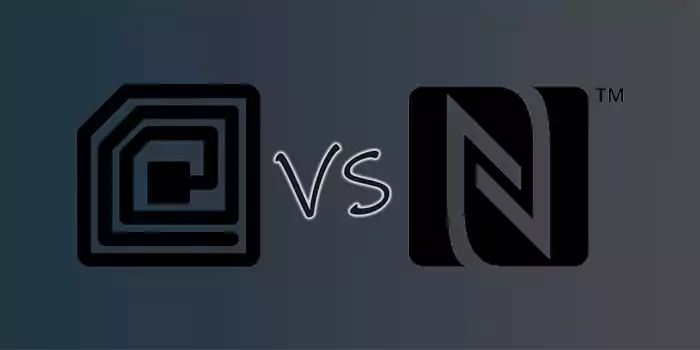NFC vs RFID, which is the best? What is the difference between NFC and RFID? These questions always confuse us. NFC technology originated from RFID technology. But there are some differences between them. Now, Asiarfid will take you to figure out three questions: What is NFC technology? What is RFID technology? And how they differ?
What is RFID?
Radio Frequency Identification (RFID) is a non-contact automatic identification technology. It automatically identifies target objects and acquires relevant data through radio frequency signals. It can work in various harsh environments without manual intervention. RFID technology can identify high-speed moving objects and multiple tags at the same time, which is fast and convenient to operate. 【More about RFID】
What Are The Applications Of RFID?
There are many uses of RFID. It can be used to coordinate and control access in different sectors, such as industrial plants or factories. As such, these tags can improve the productivity of industrial processes and reduce waste by monitoring the use of raw materials and finished products.
It is also useful in managing and monitoring assets, such as commercial trucks or containers in ports or airports. In this way, you avoid losses caused by theft or mishandling.
For example, if a company has several warehouses, they can locate their goods wherever they go by simply installing an RFID reader at the entrance of each warehouse.
RFID technology can also be used in many other areas such as:
- Identification and access control
- Vehicles tracking
- Tracking of animals/pets,
- Payment systems (integration with credit cards) and mobile phones
What is NFC?
NFC technology is derived from contactless radio frequency identification (RFID). It is a kind of near-distance wireless communication technology. Like RFID, NFC is also transmitted by electromagnetic induction coupling. However, there are still big differences between the two. First, NFC is a wireless connection technology that provides easy, secure, and fast communication. Its transmission range is smaller than that of RFID. For example, NFC Cards. Then, NFC is compatible with the existing contactless smart card technology. And it has become a formal standard supported by more and more major manufacturers. Finally, because NFC is a close-range connection protocol, it is more private and secure than other connections.
What Are The Applications Of NFC?
NFC has several applications, including file transfer between smartphones, payment systems, public transport ticketing, and contact access control cards.
Additionally, NFC readers can be fixed in specific places for fast data transfer. An example of this is ATMs, where you have to tap your credit card on a reader so it can read some useful information such as account number, expiration date, and security code.
This way, making an online purchase is secure since no one will be able to steal your password or bank account during the payment – unless they get access to that NFC device (ATM) which stores your banking details.
Another application for NFC tags is in advertising. A lot of companies want their message out there but not everyone has enough money to buy television ads. These companies create special items containing the company’s logo with an NFC tag embedded inside them – so when someone walks nearby with an NFC-enabled mobile, the tag will be scanned and a message pops up.
NFC tags can also be used to launch applications or specific actions on your device. You might have seen this in action in public places where you are asked not to use your phone but rather tap it against a reader.
One example of this is Google Wallet where you can make online purchases by tapping your mobile against an NFC reader. This action launches Google Wallet into transferring the required data to complete the transaction.
What’s the Difference Between NFC and RFID Technology?
1. Working Frequency: The working frequency of NFC is 13.56 MHz. And the working frequency of RFID includes low frequency(125 kHz), high frequency (13.56 MHz), and ultra-high frequency(860~960Mhz).
2. Working Distance: The working distance of NFC is theoretically 0-20 cm. But in the realization of the product, because of the special power suppression technology, the working distance of NFC is only 0-10 cm. That can better guarantee the security of the business. Due to RFID has different frequencies, its working distance varies from several centimeters to tens of meters.
3. Working Mode: NFC supports both read-write mode and card mode. In RFID, card readers and contactless cards are two independent entities, which can not be switched.
4. Point-to-point Communication: NFC supports P2P mode and RFID does not support P2P mode.
5. Application Areas: RFID is more used in production, logistics, tracking, and asset management. NFC often works in access control, bus cards, mobile payments, and other fields.
6. Standard Protocol: NFC protocol is compatible with high-frequency RFID, that is, ISO14443/ISO15693. NFC technology also defines a relatively complete upper protocol. For example, LLCP, NDEF, and RTD.
| Item | RFID | NFC |
|---|---|---|
| Introduction | Short for Radio Frequency Identification, one of automatic identification technology. | Short for Near Field Communication, a new technology, originated from RFID. |
| Main Feature | – Wide applicability | – Short distance |
| – Can read multiple tags simultaneously | – High bandwidth | |
| – High efficiency | – Low energy consumption | |
| – Uniqueness | – High safety | |
| – Long reading distance | – Peer-to-peer | |
| – Tags transmit and read data | – Compatible with RFID | |
| – Tags transmit data | ||
| Frequency | – LF: 125 kHz | – 13.56MHz |
| – HF: 13.56MHz | ||
| – UHF:860~960 MHz | ||
| Read Range | – Passive: 1-10m | – 0 cm- 10cm |
| – Active: 10-100m | ||
| Popular Application | – Asset Management | – Mobile payment |
| – Inventory Management | – Electronic ticketing | |
| – Animal Tracking | – Access control | |
| – Parking Management | – Mobile identity identification | |
| – Vehicle Tracking | – Anti-counterfeiting | |
| – Production Management | ||
| – Logistics Tracking |
Related Articles
- How To Program NFC Tags
- What Is NFC Payment?
- Phones With NFC In 2021-List Of NFC-Enabled Mobile Devices
- How To Use NFC On IPhone – Here’s What You Need To Know!
- 12 Best NFC Tag Uses That Will Make Your Life Fun
- Learn All About Different Types Of RFID Tags
- A Beginner’s Guide – What Is An NFC Tag?
- The Reason Why Everyone Love NFC Wristband


